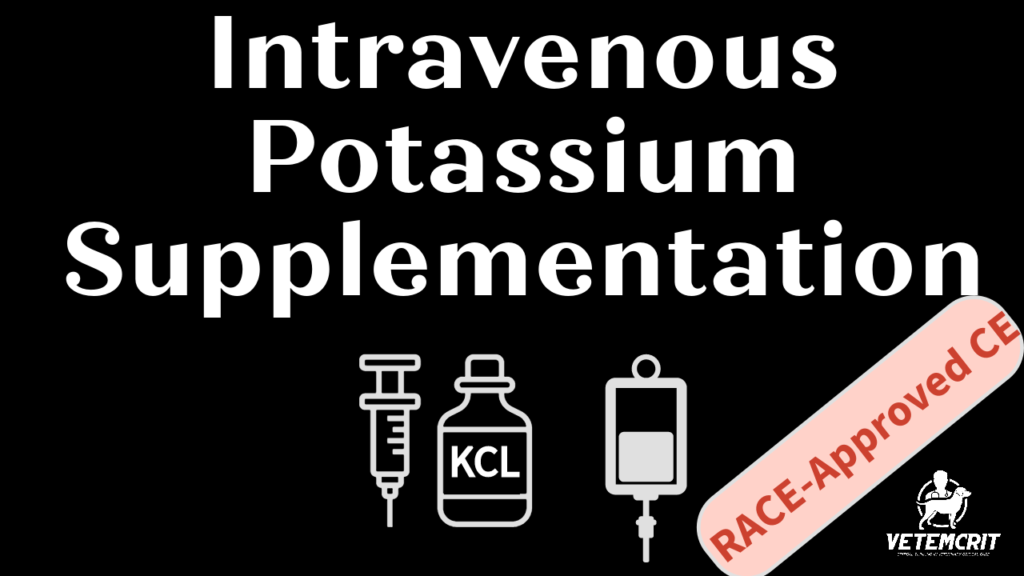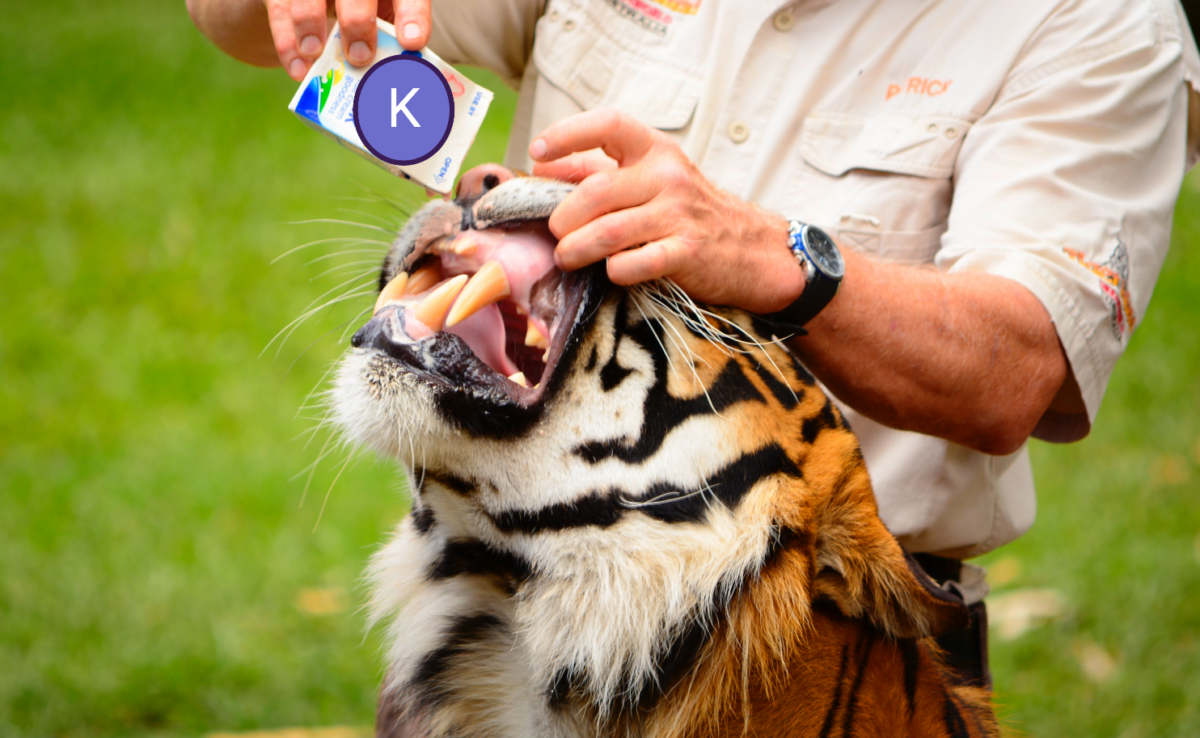All causes of hypokalemia can be divided into 3 big groups:
- Decreased intake (unlikely to be a sole cause)
- Intracellular shift
- External loss (GI or renal)
A step-by-step approach to diagnosis of hypokalemia
Step 1: Review current medication history. Drugs that can promote hypokalemia (via intracellular shifting or increased losses/decreased intake):
- K-deficient fluids
- loop/thiazide diuretics
- insulin, dextrose
- albuterol, terbutaline and other beta agonists
- catecholamines
Step 2: Consider patient’s signalment
- Is it a young Burmese cat?
- A syndrome characterized by recurrent episodes of limb muscle weakness, neck ventroflexion, increased creatine kinase concentrations, and hypokalemia has been reported in related Burmese cats 4 to 12 months of age (Malik et al. 2015);
- This syndrome may represent an animal model of hypokalemic periodic paralysis in humans, a familial disorder characterized by episodes of sudden translocation of potassium from ECF to ICF.
- Is it an old cat?
- All old cats should be suspected to have an aldosterone-producing adrenal tumor resulting in hyperaldosteronism leading to hypokalemia;
- Classic presentation: chronic hypokalemia, muscle weakness, arterial hypertension, mild hypernatremia, PU/PD caused by hypokalemic nephropathy (may be non-azotemic);
- Perform full abdominal ultrasound and measure aldosterone in the face of hypokalemia to confirm your suspicion;
- Medical management = Spironolactone, oral K; surgical = adrenalectomy;
- Other “old cat” endocrinopathies that may result in hypokalemia include diabetes mellitus and hyperthyroidism.

FREE RACE-Approved Online Training for Veterinarians and Veterinary Technicians
Step 3: Does the patient have GI signs or evidence of a GI disease (suggestive of K+ losses)?
- Calculating fractional excretion of K (FEK) may help you to differentiate between GI losses and renal losses if it is not clear from the history or a patient is suspected to have both a GI and renal disease;
- FEK = (Uk/Sk)/(Ucr/Scr) x 100%
- Uk – urine potassium; Sk – serum potassium; Ucr – urine creatinine; Scr – serum creatinine
- In one study (Adams et al. 1991), FEK values for normal cats were 10.6 +/- 2.1%; in other words, if FEK > 10-12%, the patient has excessive renal losses of K+; If FEK <10-12%, the cause of hypokalemia is GI losses and/or intracellular shifting of K+;
- In another study (Dow et al. 1990) of normal cats receiving a potassium-deficient diet, FEK values decreased from 10% to 12% to 3% to 6%;
- FEK values up to 6% should probably be considered normal in potassium-depleted animals with normal renal function;
- The clinical utility of FEK calculations is limited by the fact that FEK does not correlate well with 24-hour urinary excretion of potassium.
Step 4: Is there a possibility of a refeeding syndrome?
- During refeeding after prolong starvation (usually more than 3-4 days), relative increase in blood glucose leads to increased insulin and decreased secretion of glucagon. Insulin stimulates glycogen, fat, and protein synthesis. This process requires minerals such as phosphate and magnesium and cofactors such as thiamine. Insulin stimulates the absorption of potassium into the cells through the sodium-potassium ATPase symporter, which also transports glucose into the cells. These processes result in a decrease in the serum levels of phosphate, potassium, and magnesium, all of which are already depleted.

Step 5: Does the patient have evidence of renal disease?
- Recent urethral obstruction, once alleviated, may lead to a post-obstructive diuresis resulting in K+ wasting;
- Presence of azotemia, PU/PD, isosthenuria are suggestive of intrinsic renal disease that may lead to K+ wasting;
- Calculating FEK may help a clinician to rule in an excessive K+ wasting via renal losses (see step 3);
- Cats may develop diet-induced hypokalemic nephropathy.
Step 6: What is the Acid-base status?
- Alkalemia may lead to hypokalemia due to intracellular K shifting and impaired K+ absorption in the distal renal tubules;
- Hyperchloremic metabolic acidosis may be indicative of renal tubular acidosis that may also result in hypokalemia;
- Patients with diabetic ketoacidosis usually have total body K+ depletion, however they can present initially with normal or high potassium due to insulin deficiency and hyperosmolar pull of K+ into extracellular space.
Treatment of hypokalemia
- Identify an underlying cause of hypokalemia and address it (see the approach to diagnosis above);
- Supplement K+ parenterally and/or orally (instructions are below)
Indications for parenteral administration:
- Moderate to severe hypokalemia (<3 mEq/L);
- A patient needs to be hospitalized and does not tolerate oral medications;
- A patient receives IV fluids that can be easily supplemented with K+.
Preparations available for parenteral use (USA) include
- KCl solution (2 mEq of K per mL);
- potassium phosphate solution containing K2 HPO4 and KH2 PO4 (K = 4.36 mEq K/mL; Phosp = 3.003 mmol/ml; osmolality = 5840 mosm/kg)
General rules on parenteral K+ supplementation
- The concentration of potassium in the infused fluid generally should not exceed 60 mEq/L if administered peripherally, because higher concentrations of potassium may cause pain and sclerosis of peripheral veins (Rose et al. 1994);
- Parenteral fluids containing up to 35 mEq/L have been used safely by the subcutaneous route (Finco et al. 1977);
- Patients receiving >0.1-0.2 mEq/kg/hr of K+ should have K+ monitored every 4-6 hours;
- Patients receiving >0.4 mEq/kg/hr of K+ should have ECG monitoring and q4h K+ monitoring
- In general, I don’t recommend to exceed 0.5 mEq/kg/hr (K max), however there are some exceptions. In hypokalemic human patients, potassium infusion rates up to 0.9 mEq/kg/hr were used safely in one study (Hamill et al. 1991). Careful mixing of potassium chloride after addition to flexible bags of fluids is extremely important; the rates above >0.5 mEq/kg/hr can be used ONLY in situations of life-threatening symptomatic hypokalemic when you don’t have time to supplement K slower or during CPR;
- It is advised to calculate K+ supplementation in mEq/kg/hr and then translate this value into how much K+ solution you will add to a liter of IV fluids;
- Approximate guidelines:

- A case example: a 10 kg dog with parvovirus and hypokalemia of 2.7 mmol/l; the dog receives 70 ml/hr of LRS to account for dehydration, maintenance and ongoing losses that you previously calculated
- Step 1 – choose your K+ supplementation rate: E.g. you decide to supplement 0.3 mEq/kg/hr of KCL based on the above guideline
- Step 2 – calculate a total amount of KCL that the dog will need per hour = 10 kg x 0.3 mEq = 3 mEq/hr
- Step 3 – calculate for how many hours a liter of LRS will last at current infusion rate of 70 ml/hr. To do that, divide 1000 ml by 70 ml/hr = around 14.2 hours
- Step 4 – calculate how much KCL you will need to add to the entire bag: Multiply the number of hours by your desired K+ supplementation rate expressed in mEq/hr = 14.2 hr x 3 mEq/hr = 42.6 mEq of KCL that need to be added to a liter of fluid; since LRS contains 4 mEq/L of K+, you may subtract this number from 42.6, and you will get 38.6 mEq (total)
- Since KCL concentration is 2 mEq/ml, you will need to add 38.6 mEq/2 mEq = 19.3 ml of KCL solution to a liter of LRS to provide 0.3 mEq/kg/hr of K+ supplementation at a 70 ml/hr fluid rate
- You have to recheck serum K in 4-6 hours if K+ is being supplemented at this rate (>0.1-0.2 mEq/kg/hr)
- If you change a fluid rate, you must recalculate your KCL supplementation rate. For example, the same dog is rehydrated now, and you decrease your total fluid rate to 40 ml/hr. How much K+ is this dog receiving per hour if you are utilizing the same bag of LRS with added 38.6 mEq of KCL to it?
- Step 1: Calculate how much of K+ this fluid contains per ml. To do that, divide a total amount of K+ in this bag by 1000 ml = 42.6 mEq /1000 = 0.0426 mEq of K+ per ml
- Step 2: Multiply K+ concentration in this bag (mEq/ml) by your current fluid rate: 40 ml/hr x 0.0426 mEq/ml = 1.7 mEq/hr
- Step 3: Calculate how much K+ per kg per hour this dog is currently on: 1.7 mEq/hr divided by body weight (10 kg) = 0.17 mEq/kg/hr
- That means that when you decreased the fluid rate from 70 ml/hr to 40 ml/hr, you dropped your K+ supplementation from 0.3 mEq/kg/hr to 0.17 mEq/kg/hr.
Correction of hypokalemia in patients with hypophosphatemia (most commonly in patients with DKA)
- Potassium phosphate solution contains: K+ = 4.4 mEq/ml and Phosphate = 3 mM/ml
- Serum potassium concentration must be taken into account when giving potassium phosphate for correction of hypophosphatemia.
- Blood phosphorous is recommended to correct using this rate: 0.03 to 0.12 mM/kg/hr.
Case example: A 10 kg dog with DKA; serum K = 3 mmol/l, serum PO4 = 1 mmol/l (RR, 2.6-7 mmol/l); fluid rate = 40 ml/hr
- Step 1: choose your phosphorous supplementation rate: e.g. you decided to supplement 0.1 mM/kg/hr of phosphorous = 10 kg x 0.1 mM/kg/hr = 1 mM/hr = 0.33 ml of KPhos solution (3mM/ml) per hour;
- Step 2: calculate the total amount of KPhosph to be added to a liter of bag =
- 1000 ml/ 40ml/hr = 1 L LRS bag will last 25 hours at 40 ml/hr rate
- 25 hours x 0.33 ml = 8.25 ml of KPhosph to be added to a liter of IV fluids to supplement 0.33 ml of KPhosph per hour;
- Step 3: calculate how much K+ this patient will be receiving with this Kphosph supplementation rate = 0.33 ml/hr x 4.4 mEq/ml of K+ = 1.45 mEq/hr = 0.145 mEq/kg/hr (for a 10 kg dog); since this dog has a hypokalemia of 3 mmol/l, this amount of K+ may be enough; if hypokalemia is more severe, you may add more KCL to the same bag using previous calculations;
Oral preparations
- Potassium gluconate (e.g., Kaon and Tumil-K) is recommended for oral supplementation. In one study, orally administered KCl and KHCO3 were not palatable to cats;
- Tumil-K tablet – 2 mEq (468 mg);
- Tumil K gel – Each 2.34 g (1/2 teaspoon) contains 2 mEq (468 mg) of Potassium gluconate;
- Tumil K powder – ¼ Teaspoon of powder contains 2 mEq of K+;
- Dogs may require 2 to 44 mEq potassium per day, depending on body size;
- In cats with hypokalemic nephropathy, the initial oral dosage of potassium gluconate is 5 to 8 mEq/day divided in two or three doses, whereas the maintenance dosage can usually be reduced to 2 to 4 mEq/day;
References
Malik R, Musca FJ, Gunew MN, et al. Periodic hypokalaemic polymyopathy in Burmese and closely related cats: a review including the latest genetic data. J Feline Med Surg. 2015;17(5):417-426. doi:10.1177/1098612X15581135;
Adams LG, Polzin DG, Osborne CA, et al. Comparison of fractional excretion and 24-hour urinary excretion of sodium and potassium in clinically normal cats and cats with induced chronic renal failure. Am J Vet Res 1991;52:718;
Dow SW, Fettman MJ, Smith KR, et al. Effects of dietary acidification and potassium depletion on acid-base balance, mineral metabolism and renal function in adult cats. J Nutr 1990;120:569;
Hamill RJ, Robinson LM, Wexler HR, et al. Efficacy and safety of potassium infusion therapy in hypokalemic critically ill patients. Crit Care Med 1991;19:694;
Rose BD. Hypokalemia. In: Rose BD, editor. Clinical physiology of acid-base and electrolyte disorders. New York: McGraw-Hill; 1994. p. 811;
Finco DR. Fluid therapy. In: Kirk RW, editor. Current veterinary therapy VI. Philadelphia: WB Saunders; 1977. p. 8.


Thank you for your sharing. I am worried that I lack creative ideas. It is your article that makes me full of hope. Thank you. But, I have a question, can you help me?
I don’t think the title of your article matches the content lol. Just kidding, mainly because I had some doubts after reading the article.
I don’t think the title of your article matches the content lol. Just kidding, mainly because I had some doubts after reading the article.
Can you be more specific about the content of your article? After reading it, I still have some doubts. Hope you can help me. https://accounts.binance.com/da-DK/register-person?ref=V2H9AFPY
Thank you for your sharing. I am worried that I lack creative ideas. It is your article that makes me full of hope. Thank you. But, I have a question, can you help me? https://accounts.binance.com/pl/register-person?ref=YY80CKRN
Thank you for your sharing. I am worried that I lack creative ideas. It is your article that makes me full of hope. Thank you. But, I have a question, can you help me? https://accounts.binance.com/pl/register-person?ref=YY80CKRN
Your point of view caught my eye and was very interesting. Thanks. I have a question for you.
Can you be more specific about the content of your article? After reading it, I still have some doubts. Hope you can help me.